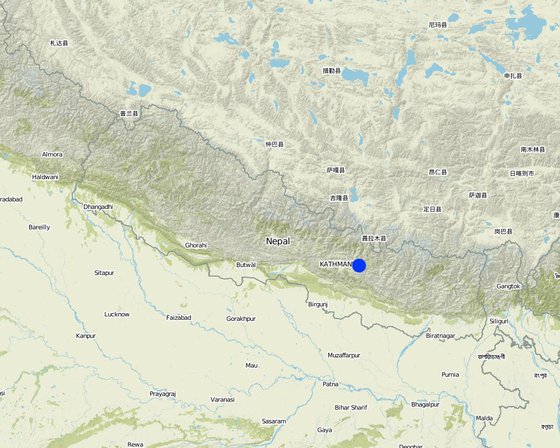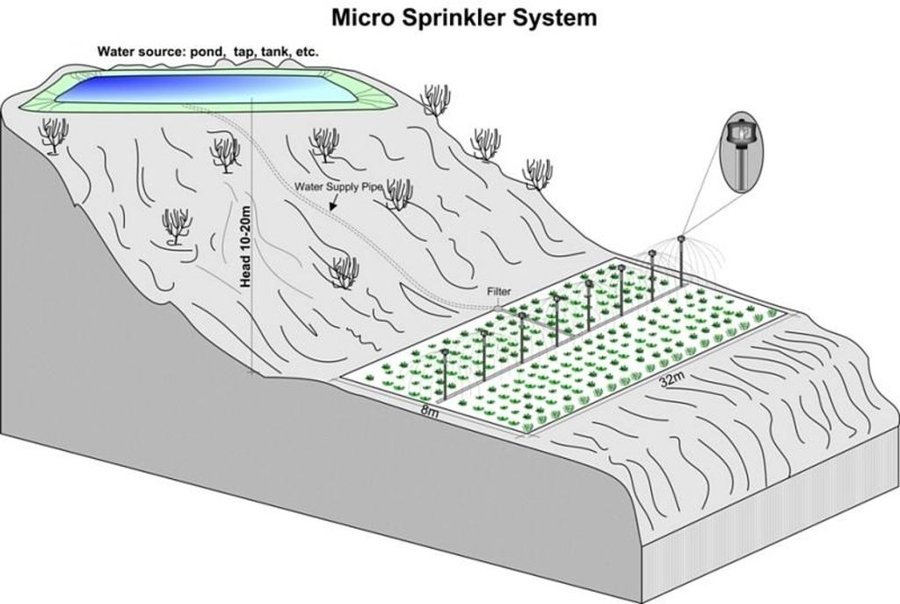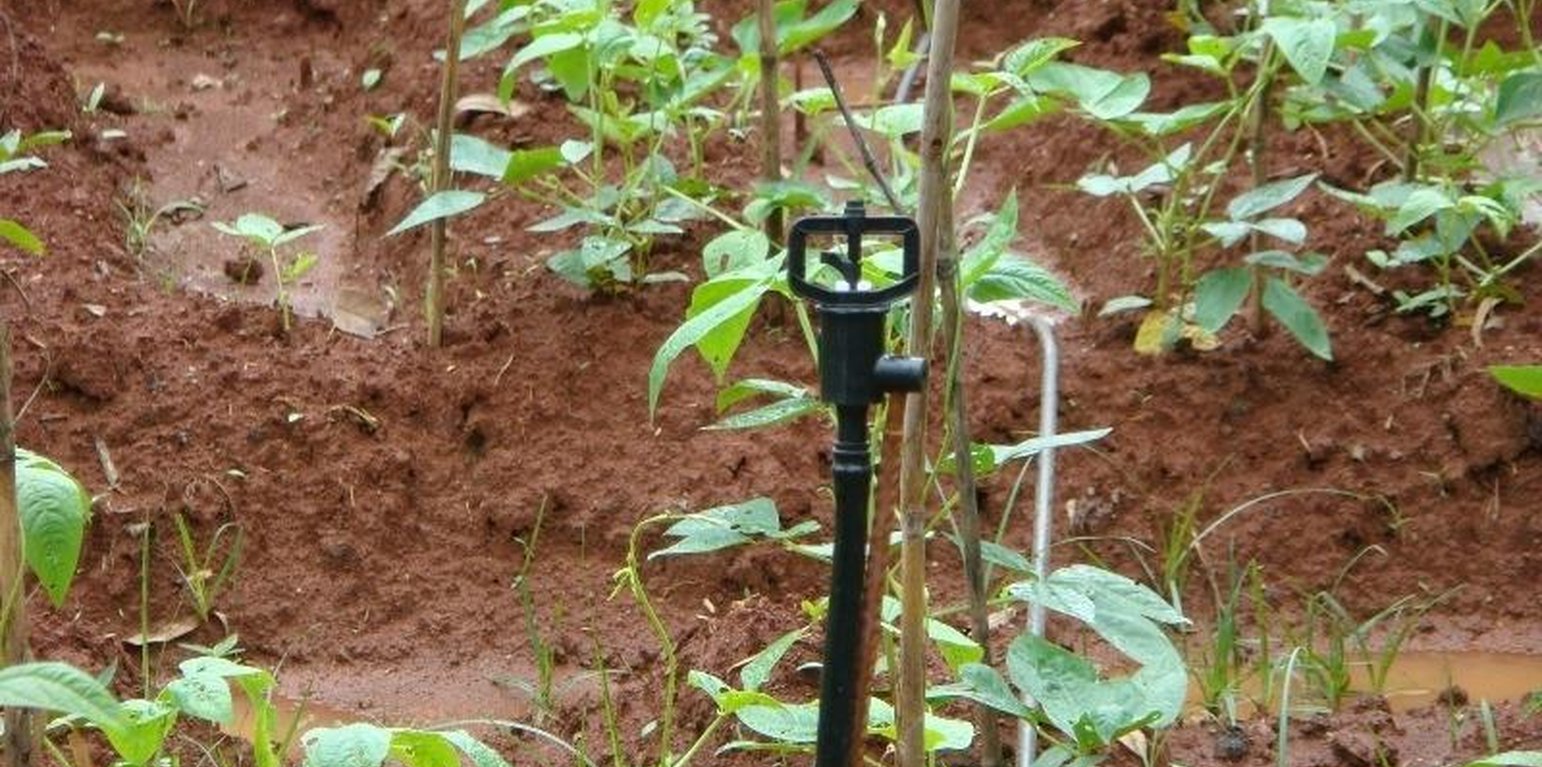Low cost micro-sprinkler irrigation
(Nepal)
Phohara sinchai - Nepali
Description
An irrigation system that delivers small-sized water droplets through a rotating head allowing longer watering time with less runoff
Micro-sprinkler irrigation is an efficient and alternative method of irrigation for high value cash crops. It has been demonstrated in the Jhikhu Khola watershed (JKW) in Nepal’s middle mountains by the People and Resource Dynamics in Mountain Watersheds of the Hindu Kush-Himalayas Project (PARDYP). The NGO International Development Enterprises (IDE-Nepal) has assisted private companies to assemble and market micro-irrigation systems.
Micro sprinklers are available in a variety of configurations. They operate at a low-pressure, with water delivered at a pressure equivalent to 10-20m of head, and at a low discharge rate of 0.1-0.2 lps - equivalent to the average discharge of a 1/2 inch size public tap. A pre-assembled micro-irrigation system generally consists of 4 to 8 sprinkler heads at 4m intervals connected by half inch piping. Micro sprinklers are most suitable for closely cropped vegetables like onion and garlic. PARDYP demonstrated, tested, and promoted the system to show land users the potential to use irrigation water very efficiently, which is important because water is in short supply for much of the year after the monsoon finishes in September. In the test area, much of the land is left fallow after the monsoon crops have been harvested as it is difficult to grow winter crops because of the lack of irrigation
water.
The system is easy to install and move around. It needs a reliable source of water, such as a water harvesting tank or a tap, located about 10-20m above the field to be irrigated. A water tank can be installed at the appropriate height to give an adequate water head. The preassembled micro-sprinkler heads are inserted into the ground on a support stand and are connected to the water source via a conveyance pipe. The water passes through a filter before entering the sprinkler heads to prevent the sprinklers becoming clogged up; the system needs regular cleaning.
Location

Location: Kavrepalanchowk/ Jhikhu Khola watershed, Nepal
No. of Technology sites analysed:
Geo-reference of selected sites
Spread of the Technology: evenly spread over an area (approx. 0.1-1 km2)
In a permanently protected area?:
Date of implementation: less than 10 years ago (recently)
Type of introduction
-
through land users' innovation
-
as part of a traditional system (> 50 years)
-
during experiments/ research
-
through projects/ external interventions
Classification of the Technology
Main purpose
-
improve production
-
reduce, prevent, restore land degradation
-
conserve ecosystem
-
protect a watershed/ downstream areas – in combination with other Technologies
-
preserve/ improve biodiversity
-
reduce risk of disasters
-
adapt to climate change/ extremes and its impacts
-
mitigate climate change and its impacts
-
create beneficial economic impact
-
create beneficial social impact
-
Improve efficiency of water use
Land use
-
Cropland
- Annual cropping: cereals - maize, legumes and pulses - other, root/tuber crops - potatoes, seed crops - sesame, poppy, mustard, other, wheat, tomatoes
Number of growing seasons per year: 3
Water supply
-
rainfed
-
mixed rainfed-irrigated
-
full irrigation
Purpose related to land degradation
-
prevent land degradation
-
reduce land degradation
-
restore/ rehabilitate severely degraded land
-
adapt to land degradation
-
not applicable
Degradation addressed
-
soil erosion by water - Wt: loss of topsoil/ surface erosion
SLM group
-
irrigation management (incl. water supply, drainage)
SLM measures
-
management measures - M2: Change of management/ intensity level
Technical drawing
Technical specifications
Micro-sprinkler irrigation system and technical specification.
Location: Patalekhet and Kuttal. Kavrepalanchowk district
Technical knowledge required for field staff / advisors: low
Technical knowledge required for land users: low
Main technical functions: increase / maintain water stored in soil, water spreading (efficiently)
Change of land use practices / intensity level: from conventional irrigation (flood / bucket) to efficient irrigation.

Author: A.K. Thaku
Establishment and maintenance: activities, inputs and costs
Calculation of inputs and costs
- Costs are calculated: per Technology unit (unit: Micro-sprinkler irrigation volume, length: 4 to 8 sprinkler heads at 4 m intervals)
- Currency used for cost calculation: USD
- Exchange rate (to USD): 1 USD = n.a
- Average wage cost of hired labour per day: 2.10
Most important factors affecting the costs
The system itself is a dominating factor affecting the cost.
Establishment activities
-
Identify an appropriate water source (water harvesting tank, tap, pump) (Timing/ frequency: beginning of the growing season)
-
Fix the micro-sprinkler heads in the ground with their support stands (Timing/ frequency: growing season)
-
Connect sprinkler system with water source through conveyance pipes (Timing/ frequency: growing season)
Establishment inputs and costs (per Micro-sprinkler irrigation)
| Specify input |
Unit |
Quantity |
Costs per Unit (USD) |
Total costs per input (USD) |
% of costs borne by land users |
|
Labour
|
| Installing micro-sprinkler system |
Persons/unit |
2.0 |
2.1 |
4.2 |
100.0 |
|
Equipment
|
| Sprinkler heads, pipes etc. |
unit |
1.0 |
12.2 |
12.2 |
|
| Total costs for establishment of the Technology |
16.4 |
|
| Total costs for establishment of the Technology in USD |
16.4 |
|
Maintenance activities
-
Regular monitoring of the sprinklers’ performance (Timing/ frequency: during irrigating period / regularly)
-
Cleaning nozzles if clogging problem occurs (Timing/ frequency: during irrigating period / regularly)
Maintenance inputs and costs (per Micro-sprinkler irrigation)
| Specify input |
Unit |
Quantity |
Costs per Unit (USD) |
Total costs per input (USD) |
% of costs borne by land users |
|
Labour
|
| Maintaining sprinkler system |
Persons/unit |
1.0 |
2.1 |
2.1 |
100.0 |
| Total costs for maintenance of the Technology |
2.1 |
|
| Total costs for maintenance of the Technology in USD |
2.1 |
|
Natural environment
Average annual rainfall
-
< 250 mm
-
251-500 mm
-
501-750 mm
-
751-1,000 mm
-
1,001-1,500 mm
-
1,501-2,000 mm
-
2,001-3,000 mm
-
3,001-4,000 mm
-
> 4,000 mm
Agro-climatic zone
-
humid
-
sub-humid
-
semi-arid
-
arid
Specifications on climate
Average annual rainfall in mm: 1070.0
Thermal climate class: subtropics
Slope
-
flat (0-2%)
-
gentle (3-5%)
-
moderate (6-10%)
-
rolling (11-15%)
-
hilly (16-30%)
-
steep (31-60%)
-
very steep (>60%)
Landforms
-
plateau/plains
-
ridges
-
mountain slopes
-
hill slopes
-
footslopes
-
valley floors
Altitude
-
0-100 m a.s.l.
-
101-500 m a.s.l.
-
501-1,000 m a.s.l.
-
1,001-1,500 m a.s.l.
-
1,501-2,000 m a.s.l.
-
2,001-2,500 m a.s.l.
-
2,501-3,000 m a.s.l.
-
3,001-4,000 m a.s.l.
-
> 4,000 m a.s.l.
Technology is applied in
-
convex situations
-
concave situations
-
not relevant
Soil depth
-
very shallow (0-20 cm)
-
shallow (21-50 cm)
-
moderately deep (51-80 cm)
-
deep (81-120 cm)
-
very deep (> 120 cm)
Soil texture (topsoil)
-
coarse/ light (sandy)
-
medium (loamy, silty)
-
fine/ heavy (clay)
Soil texture (> 20 cm below surface)
-
coarse/ light (sandy)
-
medium (loamy, silty)
-
fine/ heavy (clay)
Topsoil organic matter content
-
high (>3%)
-
medium (1-3%)
-
low (<1%)
Groundwater table
-
on surface
-
< 5 m
-
5-50 m
-
> 50 m
Availability of surface water
-
excess
-
good
-
medium
-
poor/ none
Water quality (untreated)
-
good drinking water
-
poor drinking water (treatment required)
-
for agricultural use only (irrigation)
-
unusable
Water quality refers to:
Is salinity a problem?
Occurrence of flooding
Characteristics of land users applying the Technology
Market orientation
-
subsistence (self-supply)
-
mixed (subsistence/ commercial)
-
commercial/ market
Off-farm income
-
less than 10% of all income
-
10-50% of all income
-
> 50% of all income
Relative level of wealth
-
very poor
-
poor
-
average
-
rich
-
very rich
Level of mechanization
-
manual work
-
animal traction
-
mechanized/ motorized
Sedentary or nomadic
-
Sedentary
-
Semi-nomadic
-
Nomadic
Individuals or groups
-
individual/ household
-
groups/ community
-
cooperative
-
employee (company, government)
Age
-
children
-
youth
-
middle-aged
-
elderly
Area used per household
-
< 0.5 ha
-
0.5-1 ha
-
1-2 ha
-
2-5 ha
-
5-15 ha
-
15-50 ha
-
50-100 ha
-
100-500 ha
-
500-1,000 ha
-
1,000-10,000 ha
-
> 10,000 ha
Scale
-
small-scale
-
medium-scale
-
large-scale
Land ownership
-
state
-
company
-
communal/ village
-
group
-
individual, not titled
-
individual, titled
Land use rights
-
open access (unorganized)
-
communal (organized)
-
leased
-
individual
Water use rights
-
open access (unorganized)
-
communal (organized)
-
leased
-
individual
Access to services and infrastructure
Impacts
Socio-economic impacts
farm income
due to increased vegetable production
Socio-cultural impacts
community institutions
an informal network of sprinkler users formed
SLM/ land degradation knowledge
livelihood and human well-being
vegetableproduction became possible with use of less water, production increased.
Ecological impacts
soil moisture
due to precise delivery of water (0.1 - 0.2 lps)
soil loss
due to uniform application of water to crops grown on slopping land
Made the irrigation of multiple vegetables possible
as users can shift the system around to irrigate
Cost-benefit analysis
Benefits compared with establishment costs
Short-term returns
very negative
very positive
Long-term returns
very negative
very positive
Benefits compared with maintenance costs
Short-term returns
very negative
very positive
Long-term returns
very negative
very positive
Climate change
Gradual climate change
annual temperature increase
not well at all
very well
Climate-related extremes (disasters)
not well at all
very well
not well at all
very well
not well at all
very well
not well at all
very well
Other climate-related consequences
not well at all
very well
Adoption and adaptation
Percentage of land users in the area who have adopted the Technology
-
single cases/ experimental
-
1-10%
-
11-50%
-
> 50%
Of all those who have adopted the Technology, how many have done so without receiving material incentives?
-
0-10%
-
11-50%
-
51-90%
-
91-100%
Number of households and/ or area covered
515 households in an area of 0.1 - 1 sq km. (200 - 500 persons / sq km)
Has the Technology been modified recently to adapt to changing conditions?
To which changing conditions?
-
climatic change/ extremes
-
changing markets
-
labour availability (e.g. due to migration)
Conclusions and lessons learnt
Strengths: land user's view
-
Sprinkler showers drive away insects
-
Is equally useful to irrigate fallow land to increase soil moisture.
Strengths: compiler’s or other key resource person’s view
-
Extremely useful for closely spaced, leafy vegetables such as onions, garlic and spinach grown in small areas.
How can they be sustained / enhanced? Suitable for row crops like bitter gourd during their initial stage of growth; and also good for a wide range of row crops (tree crops and vegetables) that require low-fl ow irrigation.
-
Most appropriate for sloping land
How can they be sustained / enhanced? Can be used on level land if tank placed
at appropriate height
-
Easy to transport, and possible to use for different crops in rotation
How can they be sustained / enhanced? Position of the sprinkler head should be changed to acquire 100% overlap of watered areas.
-
Allows uniform distribution of water and longer watering time with less runoff; therefore reduces soil loss from sloping land and increases soil moisture status.
How can they be sustained / enhanced? The technology should be shared with a wider audience
Weaknesses/ disadvantages/ risks: land user's viewhow to overcome
-
Sometimes sprinklers stop functioning as they do not rotate and can become disconnected from the pipe
Regular checking and cleaning
-
Are susceptible to being stolen as they can be easily dismantled
Regular site visits by the farmer
Weaknesses/ disadvantages/ risks: compiler’s or other key resource person’s viewhow to overcome
-
Requires sufficient head pressure therefore less suitable for plain lands.
It can be used in plain lands with alternative arrangements i.e. by constructing a platform for drum/ tank at appropriate height.
References
Reviewer
-
David Streiff
-
Alexandra Gavilano
Date of documentation: Junie 7, 2011
Last update: Sept. 5, 2019
Resource persons
-
Madhav Dhakal - SLM specialist
-
Sanjeev Bhuchar - SLM specialist
-
Isabelle Providoli - SLM specialist
Full description in the WOCAT database
Documentation was faciliated by
Institution
- ICIMOD International Centre for Integrated Mountain Development (ICIMOD) - Nepal
Project
Key references
-
ICIMOD (2007) Good Practices in Watershed Management, Lessons Learned in the Mid Hills of Nepal. Kathmandu: ICIMOD: ICIMOD








